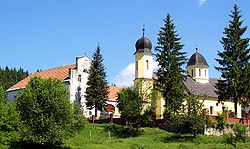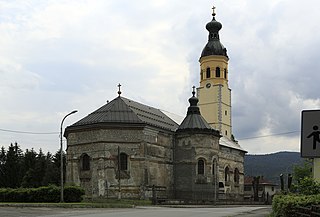
Karlovac County is a county in central Croatia, with the administrative center in Karlovac.

Sisak-Moslavina County is a Croatian county in eastern Central Croatia and southwestern Slavonia. It is named after the city of Sisak and the region Moslavina just across the river Sava. According to 2021 census it is inhabited by 141,000 people.
The Government of Croatia, formally the Government of the Republic of Croatia, commonly abbreviated to Croatian Government, is the main executive branch of government in Croatia. It is led by the president of the Government, informally abbreviated to premier or prime minister. The prime minister is nominated by the president of the Republic from among those candidates who enjoy majority support in the Croatian Parliament; the candidate is then chosen by the Parliament. There are 20 other government members, serving as deputy prime ministers, government ministers or both; they are chosen by the prime minister and confirmed by the Parliament (Sabor). The Government of the Republic of Croatia exercises its executive powers in conformity with the Croatian Constitution and legislation enacted by the Croatian Parliament. The current government is led by Prime Minister Andrej Plenković.
The Baptist Union of Croatia is a Baptist Christian association of churches in Croatia. It is affiliated with the European Baptist Federation and the Baptist World Alliance.

Croatia is a predominantly Christian country, with Islam being a minority faith. It is followed by 1.3% of the country's population according to the 2021 census. Islam was first introduced to Croatia by the Ottoman Empire during the Croatian–Ottoman Wars that lasted from the 15th to 16th century. During this period some parts of the Croatian Kingdom were occupied which resulted in some Croats converting to Islam, some after being taken prisoners of war, some through the devşirme system. Nonetheless, Austria strongly fought against the Turks during these few centuries which resulted in the fact that the westernmost border of the Ottoman Empire in Europe became entrenched on the Croatian soil. In 1519, Croatia was called the Antemurale Christianitatis by Pope Leo X in one letter, as well as Poland, Armenia or Albanians.

The Lepavina Monastery is a Serbian Orthodox monastery dedicated to the Presentation of Mary and located at the village of Sokolovac, near the town of Koprivnica in Croatia.

Christianity is the most widely professed religion in Croatia, representing 87.4% of the total population. A large majority of the Croatian population declare themselves to be members of the Catholic Church.
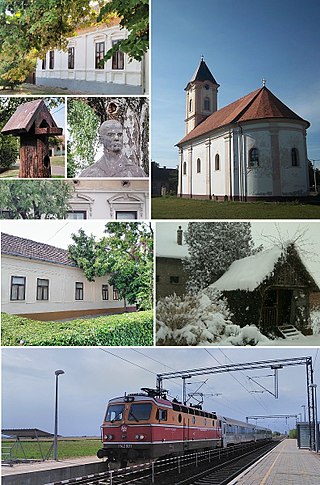
Banovci ; also known as Šidski Banovci, is a village in eastern Croatia, 7 kilometers away from the Serbian border. The village is connected with the rest of the country by the D46 state road connecting it with the town of Vinkovci and continuing into Serbia as the State Road 120 to the nearest town of Šid and by the Zagreb–Belgrade railway.
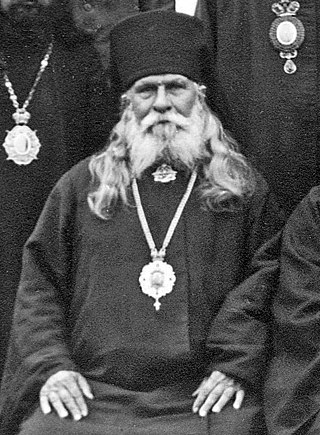
Metropolitan Germogen, secular name Georgy Ivanovich Maximov, was bishop of Aksay, Vicar of the Don Diocese, 23rd Bishop of Yekaterinoslav and Novomoskovsk, Governor of the Russian Orthodox municipalities on Crete and North Africa with a seat in Athens (1922), Archbishop of Yekaterinoslav and Novomoskovsk (1922–1942), member of the Synod of Bishops of the Russian Orthodox Church Abroad (1924–1942), the head of the Croatian Orthodox Church (1942–1945).

Eparchy of Osječko polje and Baranja is an eparchy (diocese) of the Serbian Orthodox Church encompassing easternmost areas of Croatia, with seat in Dalj.

The Metropolitanate of Zagreb and Ljubljana is an Eastern Orthodox eparchy (diocese) and one of the five honorary metropolitanates of the Serbian Orthodox Church. The headquarters of the metropolia is located in Zagreb, Croatia, and its jurisdiction covers northern Croatia and the entire territory of Slovenia.
The Open Letter on the Position and Status of Serbs in Croatia was sent to the addresses of prominent Croatians and Serbians in September 2008. The letter spoke about the adverse social and economic circumstances in which Croatian Serbs had lived.
Dušan Bilandžić was a Croatian historian and politician.

The Church of St. George in Varaždin is Serbian Orthodox church in Croatia. The church is dedicated to Saint George. Work on church were completed in 1884. The church is located inside of Varaždin's main market place.

Serbian Orthodox Eparchy of Slavonia is an eparchy (diocese) of the Serbian Orthodox Church encompassing areas of western and central Slavonia, in modern Croatia. Since 2014, the Eparchy is headed by bishop Jovan Ćulibrk.
Croat Muslims are Muslims of Croat ethnic origin. They consist primarily of the descendants of the Ottoman-era Croats.
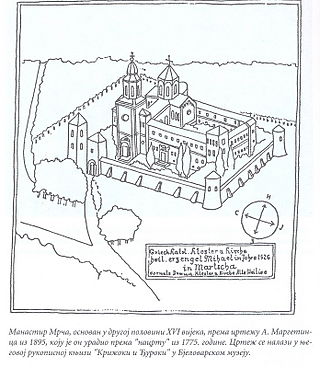
The Eparchy of Marča was an Eastern Christian ecclesiastical entity taking two forms in the 17th century: an Eastern Orthodox eparchy and an Eastern Catholic vicariate. The term was derived from the name of the monastery at Marča near Ivanić-Grad, Habsburg monarchy.
Simeon Vratanja was the first bishop of the Eparchy of Vretanija (1609–11), the westernmost eparchy of the Serbian Patriarchate of Peć, and the first bishop of the Eastern Catholic Bishopric of Marča (1611–28).
The Government of Croatia and the Holy See have signed four bilateral agreements and a protocol. Although the agreements proved controversial owing to great one-time and continuous financial and other burdens the agreements put on the Croatian state, no government of Croatia ever attempted to amend them. From the perspective of international law, these agreements may be seen as unjust to Croatia because of putting obligations chiefly on the Croatian state, but not on the Holy See.
